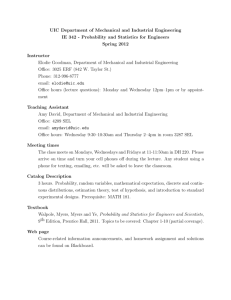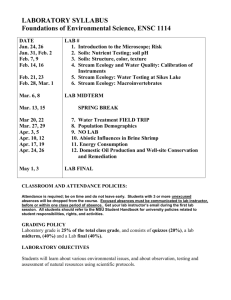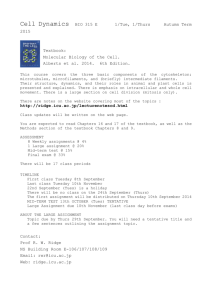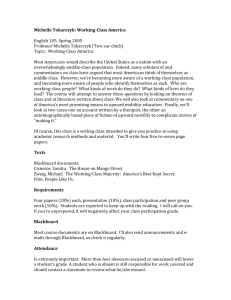Econ 322 (Public Economics) Syllabus Spring 2013
advertisement
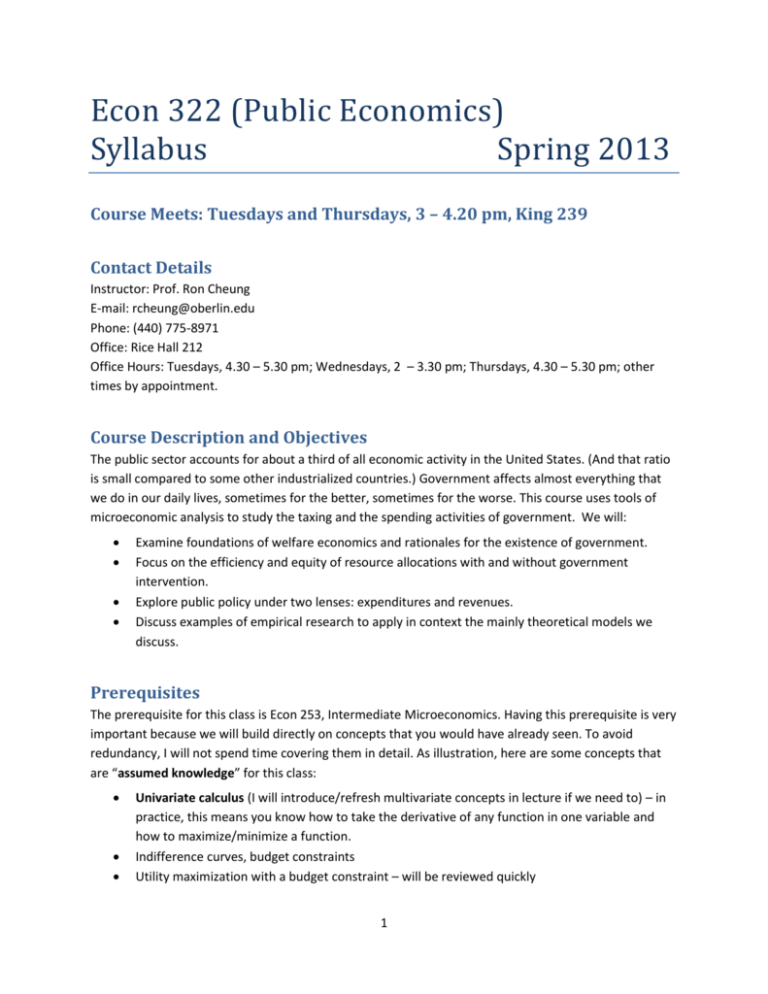
Econ 322 (Public Economics) Syllabus Spring 2013 Course Meets: Tuesdays and Thursdays, 3 – 4.20 pm, King 239 Contact Details Instructor: Prof. Ron Cheung E-mail: rcheung@oberlin.edu Phone: (440) 775-8971 Office: Rice Hall 212 Office Hours: Tuesdays, 4.30 – 5.30 pm; Wednesdays, 2 – 3.30 pm; Thursdays, 4.30 – 5.30 pm; other times by appointment. Course Description and Objectives The public sector accounts for about a third of all economic activity in the United States. (And that ratio is small compared to some other industrialized countries.) Government affects almost everything that we do in our daily lives, sometimes for the better, sometimes for the worse. This course uses tools of microeconomic analysis to study the taxing and the spending activities of government. We will: Examine foundations of welfare economics and rationales for the existence of government. Focus on the efficiency and equity of resource allocations with and without government intervention. Explore public policy under two lenses: expenditures and revenues. Discuss examples of empirical research to apply in context the mainly theoretical models we discuss. Prerequisites The prerequisite for this class is Econ 253, Intermediate Microeconomics. Having this prerequisite is very important because we will build directly on concepts that you would have already seen. To avoid redundancy, I will not spend time covering them in detail. As illustration, here are some concepts that are “assumed knowledge” for this class: Univariate calculus (I will introduce/refresh multivariate concepts in lecture if we need to) – in practice, this means you know how to take the derivative of any function in one variable and how to maximize/minimize a function. Indifference curves, budget constraints Utility maximization with a budget constraint – will be reviewed quickly 1 Income and substitution effects (conceptual) Econometrics/statistics, regression analysis and knowing how to read regression results are useful, but not obligatory. NOTE: “Assumed knowledge” means you’re not a complete stranger to it, but that you’ll be able to recall quickly anything you might have forgotten from intermediate micro. I will try to help by doing lots of examples to remind you of the theory along the way. Textbook and Course Materials Textbook. The required textbook for this course is Richard W. Tresch, Public Sector Economics, PalgraveMacMillan. Supplementary and optional books. The following three books are less mathematically rigorous public finance textbooks. They are not meant to replace the textbook but give better coverage of the policy implications of our theoretical models. Harvey S. Rosen & Ted Gayer, Public Finance, 9th edition, McGraw-Hill, 2010. Holley H. Ulbrich, Public Finance in Theory and Practice, 2nd edition, Routledge, 2011. Jonathan Gruber, Public Finance and Public Policy, 3rd edition, Worth, 2010. Finally, the following book is more mathematically rigorous than our textbook, for those of you who may be interested in reading more about the theory, or those of you who want to see calculus used extensively: Jean Hindriks & Gareth Myles, Intermediate Public Economics, MIT Press, 2006. Readings. There will be some additional readings from academic journals and other texts that will supplement our textbook. These will be made available on Blackboard, and I expect you to have read them in preparation for the lecture where we discuss them. Blackboard. As a registered student, you should be able to view the Blackboard page for this course. This is the site where I will post lecture notes, additional study material and announcements for this course. It is your responsibility to check the site often. Lecture notes will generally be posted a few days before the lecture we cover them in. I recommend that you print them out and bring them to class so that you can take notes on them. Note that the lecture notes are incomplete, as we will fill in the missing graphs, diagrams and equations during the lecture. If you miss a lecture, it is your responsibility to find a classmate who attended class to fill in the blanks. Grading There are five components to your course grade. Participation (10%). I value your participation and expect you to take an active role in this class. This includes attending class, contributing to classroom discussion and reading assigned materials in advance of the lecture. Attendance will factor into your classroom participation grade, but it is not the only factor in its determination. Random attendance checks may be taken at any time. 2 Assignments (15%). There will be about six homework assignments, which will be posted on Blackboard. The assignment with the lowest mark will be dropped from your final grade. You will have at least one week to complete the assignment. You are permitted to work with at most one other student on assignments; if you do so, you should hand in one assignment with both your names on it. You MUST hand in your assignment in the first fifteen minutes of the class that it is due (in other words, between 3 and 3.15 pm). Here are the penalties for lateness: Handed in during class but after the first 15 minutes: 20% penalty. If you intend on doing this, please hand your assignment in at the end of the class to avoid disturbing the lecture. Handed in within 24 hours of due time: 30% penalty. Handed in after 24 hours: 100% penalty. (I will still grade it and give comments.) Exceptions can be made for documented reasons. Policy Briefs (20%: 10% per brief). You will explore in more detail two specific government policies of your choosing by writing policy briefs. They should be six to eight double-spaced pages, no more, no less. You should cover the economic motivation and brief history of the policy; the political and economic factors in its design; the implementation, successes/failures and winners/losers; and any prescription for altering the policy in the future. The first policy brief will cover a public expenditure policy, while the second brief will cover a public revenue policy. You may choose a federal, state or local policy. More information will be given to you about this requirement, including sample topics, later. Midterm (25%). There will be one in-class midterm exam held on Tuesday, 19 March 2013. The exam will be a combination of short-answer problems and short-essay questions. The exam will be open-book and open-notes. The midterm will last 1 hour and 20 minutes. Final Exam (30%). There will be a cumulative two-hour final exam. It will be a take-home exam, in which you may pick up the exam any time from Wed., 15 May through Sat., 18 May, and work on it for two hours. It is up to you to make sure that travel plans do not interfere with your ability to take the final exam. The exam will be open-book and open-notes. Exam Absences If you have documented, verifiable and serious reason to miss an exam, you must provide the proof to me within 48 hours of the exam, or you will receive a zero for it. Depending on the severity of your reason for absence, you will either take a make-up exam or the weight of the missed midterm will be shifted to the final exam. An excused absence for the final exam will be made up for according to the policy of the college. Honor Code The College requires that students sign an "Honor Code" for all assignments. Presenting the work of someone else as your own is a serious affront to the other students in the course and to me. On each assignment and policy brief that you submit, you must write "I have adhered to the Honor Code in this assignment" and sign your name in assent. (If you hand in an assignment with a classmate, you must both write and sign the affirmation.) 3 In-Class Ethics Laptops in the class are okay for the purposes of note-taking and to reference journal articles when we are discussing them. Laptops and cell phones are not to be used for other purposes, such as e-mails, text messaging, Facebook, etc. Please contribute to classroom discussion, but try not to disrupt other students’ learning by arriving late, leaving the classroom frequently, going off-topic, etc. If you must arrive late or leave early, please let me know if possible, and sit by the door. Students with Disabilities If you have specific physical, psychiatric or learning disabilities and require accommodations, please let me know early in the semester so that your learning needs may be appropriately met. You will need to provide documentation of your disability to the Office of Disability Services in Peters G-27/G-28. 4 Tentative Course Outline & Readings Textbook chapters are given in brackets. All articles and non-textbook excerpts listed will be available on Blackboard. Caveat: The course outline and readings are tentative and subject to change. We may go faster or slower than the outline below. You will be given notice of required reading relevant to class discussion. Part I: Public Economic Theory Week 1 (5, 7 Feb.) Tues., 5 Feb.: Foundations of public economics; The Efficiency-Equity Trade-off; The Size of Government; Review of some theoretical and mathematical concepts. [Ch 1] Thurs., 7 Feb.: Market failure; The Welfare Theorems; Edgeworth boxes (theory); Review continued. [Ch 2, 3] Week 2 (12, 14 Feb.) Tues., 12 Feb.: Edgeworth boxes continued. Begin externality theory. [Ch 3, 6] Thurs., 14 Feb.: Externality theory; the Coase Theorem. [Ch 6, 7] Ronald Coase, “The Problem of Social Cost,” Journal of Law and Economics, 1960, 1-44. Week 3 (19, 21 Feb.) Tues., 19 Feb.: Externalities in policy; Pigouvian taxes; Tradable permits; Measuring externalities. [Ch 7] Ayres, Ian, and Steven D. Levitt. "Measuring Positive Externalities from Unobservable Victim Precaution: An Empirical Analysis of Lojack,” Quarterly Journal of Economics 43 (1998): 44. Thurs., 21 Feb.: Public (nonexclusive) goods; free-riding [Ch 8] Paul Samuelson, “The pure theory of public expenditures,” Review of Economics and Statistics, 1954, 387-389. Week 4 (26, 28 Feb.) Tues., 26 Feb.: Lindahl pricing; Paying for public goods (Mechanism design) [Ch 8 + additional notes] Thurs., 28 Feb.: Public choice – theories of the public sector, bureaucracy [Not in textbook; you will be given supplemental reading] Lars Feld & John Matsusaka, “Budget Referendums and Government Spending: Evidence from Swiss Cantons,” Journal of Public Economics, 2000, 2703-2724. 5 Week 5 (5, 7 Mar.) Tues., 5 Mar.: Public choice: Voting; Voting systems; Arrow’s theorem [p. 73-75 + Supplemental reading] Thurs., 7 Mar.: Empirical analysis of voting David Lee, Enrico Moretti and Matthew Butler, “Do Voters Affect or Elect Policies? Evidence from the U.S. House,” Journal of Political Economy 2004, 807-859. Part II: Expenditures Week 6 (12, 14 Mar.) Tues., 12 Mar.: Primer on the social welfare function; The aversion to inequality; Measuring income inequality. [Ch 4, 5 – parts] Thurs., 14 Mar.: Transfer programs in the U.S.; in-kind vs. cash transfers; broad-based vs. targeted transfers. [Ch 10-11 – parts] Week 7 (19, 21 Mar.) Tues., 19 Mar.: MIDTERM EXAM. Thurs., 21 Mar.: Education and the public rationale. [Not in textbook; supplementary material will be provided.] David Figlio, Thomas Husted and Lawrence Kenny, “Political economy of the inequality in school spending,” Journal of Urban Economics, 2004, 338-349. SPRING BREAK (26, 28 Mar.) Week 8 (2, 4 Apr.) Tues., 2 Apr.: Social insurance and Social Security. [Ch 12] CBO Memorandum, “Social Security and Private Saving: A Review of the Empirical Evidence,” 1998. Thurs., 4 Apr.: Social Security challenges and reform. [Ch 12] First policy brief due! Part III: Taxation Week 9 (9, 11 Apr.) Tues., 9 Apr.: Overview of tax theory; goals of tax policy; the tax base debate; horizontal vs. vertical equity. [Ch 13] 6 Thurs., 11 Apr.: Personal income tax. [Ch 14] Week 10 (16, 18 Apr.) Tues., 16 Apr.: Excess burden of taxation. [Ch 15] Thurs., 18 Apr.: Optimal taxation. [Ch 16 + supplementary material] Week 11 (23, 25 Apr.) Tues., 23 Apr.: Private information; Tax evasion. [Ch 17] Thurs., 25 Apr: Tax evasion – policy experiments. [Ch 17] Joel Slemrod, Marsha Blumenthal and Charles Christian, “Taxpayer Response to an Increased Probability of Audit: Evidence from a Controlled Experiment in Minnesota,” Journal of Public Economics, 2001, 455-483. Part IV: Subnational Governments Week 12 (30 Apr., 2 May) Tues., 30 Apr.: Club goods; local public finance. [Not in textbook; supplementary reading will be given.] Charles Tiebout, “A pure theory of local expenditure,” Journal of Political Economy, 1956, 416-424. Thurs., 2 May: Local public finance continued. Paul Rhode and Koleman Strumpf, “Assessing the importance of Tiebout sorting: local heterogeneity from 1850 to 1990,” American Economic Review, 2003, 1648-1677. Week 13 (7, 9 May) Tues., 7 May: Fiscal federalism; assigning functions. [Ch 21] Thurs., 9 May: Grants-in-aid; equalization; the flypaper effect. [Ch 23] Second policy brief due! James Hines and Richard Thaler, “The Flypaper Effect,” Journal of Economic Perspectives, 1995, 217-26. FINAL EXAM: Pick up the exam any time between Wed., 15 May, and Sat., 18 May. Work on it for two hours. More details to follow. 7




